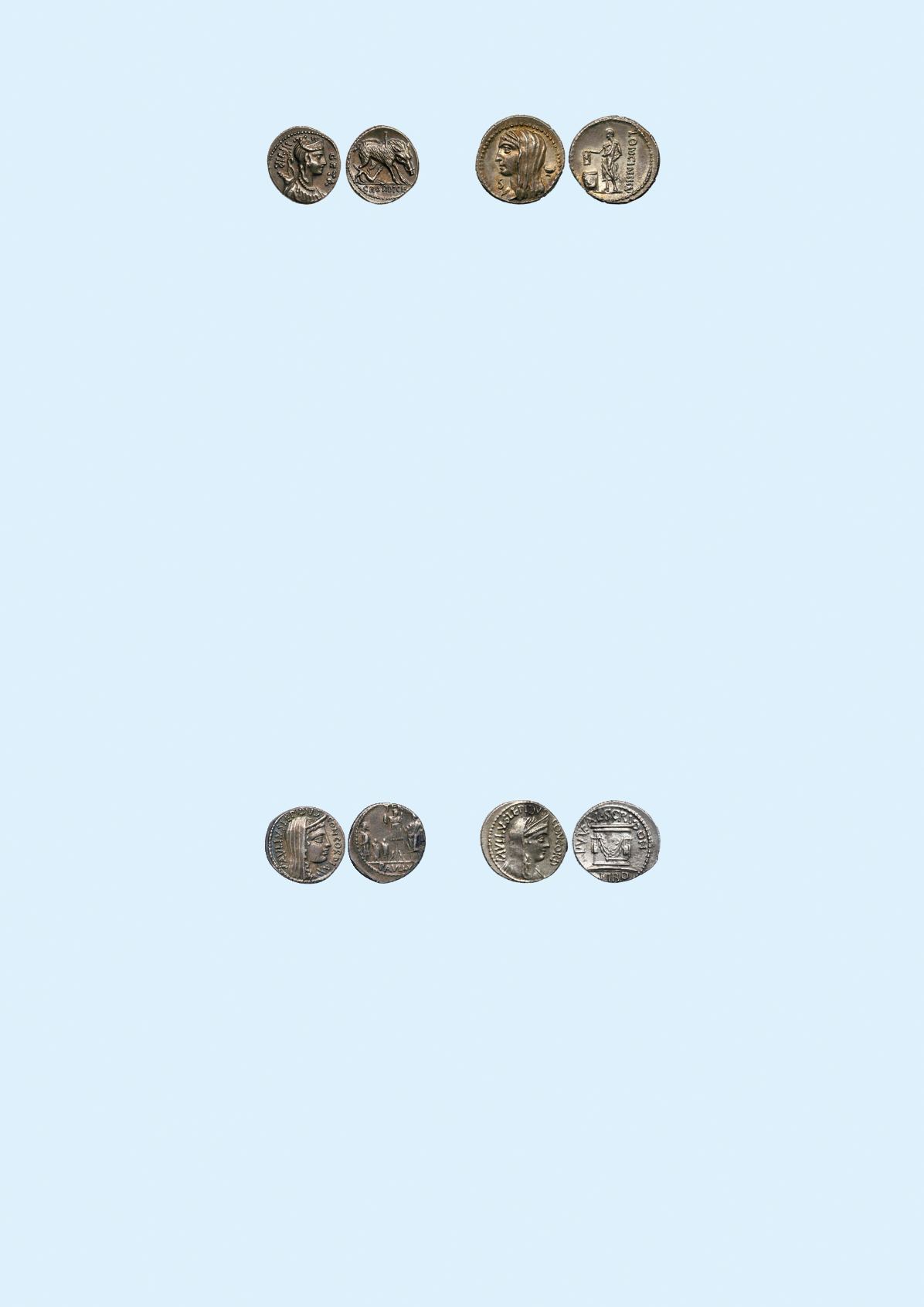
494 495
494
C. Hosidius C. F. Geta (64 BC), Silver Denarius, 3.85g. Mint of Rome.
GETA
before,
III VIR
behind, diademed
and draped bust of Diana right, bow and quiver at shoulder. Rev.
C HOSIDI C F
, the wild board of Calydon
charging right, side pierced by arrow, harried by hound below (Crawford 407/2; Sydenham 903; Hosidia 1).
Boldly struck in high relief with attractive iridescent toning, superb extremely fine.
$ 900
ex Meister & Sonntag Auction 6, 1 October 2008, lot 201
The classical myth of the Calydonian boar served to illustrate the need for paying proper respect to the gods and the consequences for
not doing so. King Oeneus of Aetolia had forgotten to accord proper rites to the goddess Diana (Artemis), and for this sacrilege she
sent a chthonic beast, the wild boar of Calydon, to ravage the Aetolian hinterland. The boar was the bane of the people, destroying
vineyards and crops and forcing everyone to take shelter behind their city walls. With starvation ensuing, a hunt was organized, and
most of the illustrious heroes of Greece’s heroic age took part (with the exception of Hercules who fought his own chthonic beast,
the Erymanthean boar). Amongst all these male heroes was one female, the heroine Atalanta, and she won the signal honor of being
the first to wound the boar, having pierced its side with an arrow. For this she was awarded its hide. Although the precise meaning is
lost to us, it can be assumed that Hosidius employed the type of the Caledonian boar to illustrate a claimed descent from one of the
heroes involved in the hunt, perhaps from Atalanta herself.
495
L. Cassius Longinus (63 BC), Silver Denarius, 3.89g. Mint of Rome. Veiled and draped bust of Vesta left,
S below chin, kylix behind. Rev.
LONGIN III V
, male figure standing left, dropping tablet inscribed
V
(Uti
rogas) into cista (Crawford 413/1; Sydenham 935; Cassia 10). Well struck on a nice broad flan, well centred
and lustrous, lightly toned, nearly mint state.
$ 900
ex CNG Auction 79, 17 September 2008, lot 939
This coin is interesting in that it appears to lack the personal and family names of the moneyer. However, appearances can be
deceiving. On the obverse below the chin of Vesta is a control letter, and the only letters employed on this issue are C, A, S, I and L.
If one collects enough coins of this moneyer, he can then spell the moneyer’s name in full. But why might a moneyer do this? In the
case of L. Cassius Longinus it appears to relate to the recent exposure and suppression of the Catiline conspiracy. One of the most
notorious members of the conspiracy whose task it was to burn down the city of Rome was one L. Cassius Longinus, but not the
same person as our moneyer!
496 497
496
L. Aemilius (62 BC), Silver Denarius, 3.85g, 8h. Mint of Rome.
PAVLLVS LEPIDVS CONCORDIA
, head of
Concordia facing right, diademed and veiled. Rev.
TER
, togate figure of L. Aemilius Paullus standing left, placing his
right hand on a trophy, to the left of which stand King Perseus of Macedon and his two sons,
PAVLLV
[
S
] in exergue
(Crawford 415/1; Sydenham 926; RBW 1497; RCV 366). Attractive iridescent toning, good very fine.
$ 150
ex Noble Numismatics, Sale 98, 22-25 November 2011, lot 5249
This moneyer was the elder brother of M. Aemilius Lepidus, who formed the Second Triumvirate with Antony and Octavian.
497
L. Aemilius Lepidus Paullus and L. Scribonius Libo (62 BC), Silver Denarius, 4.84g. Mint of Rome.
PAVLLVS
LEPIDVS CONCORD
, diademed and veiled head of Concordia right. Rev.
PVTEAL SCRIBON
above,
LIBO
in exergue, garlanded well-head decorated with two lyres and hammer (Crawford 417/1a; Sydenham 927;
Aemilia 11). Boldly struck, lustrous and lightly toned, superb extremely fine.
$ 700
ex Tkalec Auction, 27 October 2011, lot 152


